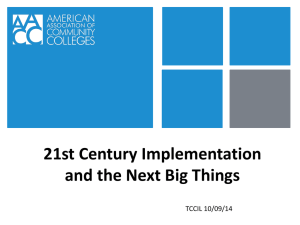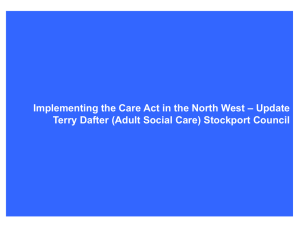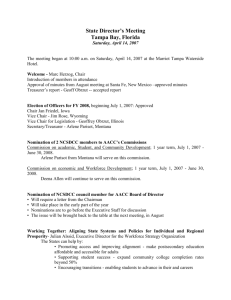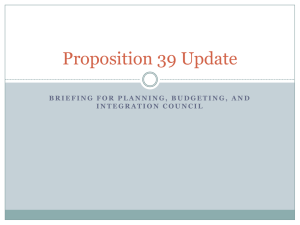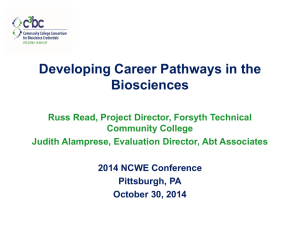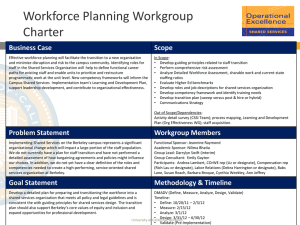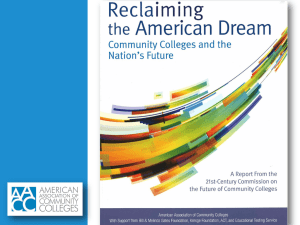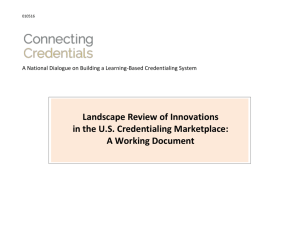Dr. Keith Bird and Kathryn Jo Manners Keynote Presentation
advertisement
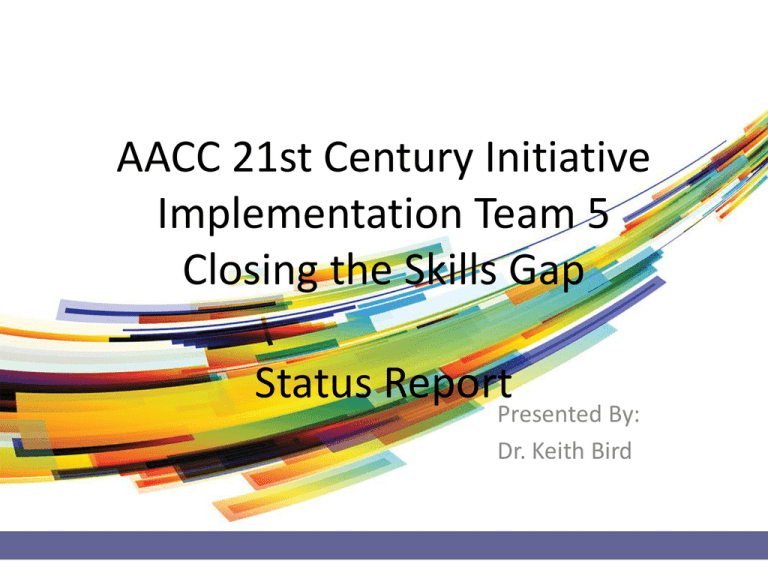
AACC 21st Century Initiative Implementation Team 5 Closing the Skills Gap Status Report Presented By: Dr. Keith Bird Session Overview • Presenter and Team Introduction • Brief Context: Report of AACC’s 21st Century Commission, Released at 2012 Convention, and Implementation Work • Charge to Implementation Team 5 • Progress report on Work Implementation Team 5 – Themes – Concerns and Challenges – Next Steps • Overall Timeline • Discussion RECLAIMING THE AMERICAN DREAM Community Colleges and the Nation’s Future Report from the 21st Century Commission on the Future of Community Colleges RECLAIMING THE AMERICAN DREAM “The American Dream is at risk… Community colleges can help reclaim that dream. But stepping up to the challenge will require dramatic redesign of these institutions, their missions, and, most critically, their students’ educational experiences.” Slide Title IT #5 - Closing the Skills Gap IT #5 - Closing the Skills Gap CHARGE Address Recommendation 3 and all three related implementation strategies from the report of the 21st-Century Commission on the Future of Community Colleges: Close the American skills gaps by sharply focusing career and technical education on preparing students with the knowledge and skills required for existing and future jobs in regional and global economies. Ensure students opportunities for career advancement and upward mobility through design of coherent career pathways leading to "stackable" credentials—multilevel, industry-recognized credentials reflecting attainment of the knowledge and skills required at different stages of a career. Build community college capacity for accurately identifying unfilled labor market needs and for ensuring that career education and training programs are streamlined to address those high-need areas. Develop technology-based tools that will help local colleges access available labor market data to identify and monitor skills gaps in their regions. CHARGE Mobilize powerful local, regional, and national partnerships (involving community colleges, employers, and government agencies) to accomplish a collaborative agenda that: ensures that program planning targets skills gaps; promotes the associate degree as a desired employment credential; establishes alternative models for completing skills-based credentials, including classroom instruction, online learning, credit for prior learning, and on-the-job learning; and develops a national credentialing system. IT #5 – Closing the Skills Gap Broad Goal: To transform the colleges’ workforce mission to position community colleges as the center of innovation, job creation and community development on a national scale (Community Colleges as a National Workforce System). • Workforce Development is broader than what most colleges practice (e.g. governance: credit, non credit, individuals and industry clients). Colleges should be leaders in economic and community development and job/talent creation. • System change elements must involve structure, increased use of data, especially LMI, and expanded employer engagement to identify both short term and long term skill requirements. Designate colleges and staff as workforce education and training leaders with certification or credentials issued through the AACC 21 Century Center which includes a National Workforce Center component. • Response time is critical. This is not just a faculty/approval issue, but the institution must support across all offices, staff, policies and procedures IT #5 – Closing the Skills Gap Major Actionable items (selected): • Develop a glossary of common language and terms for the entire report. (Examples: credit/noncredit, stackable certificates, certifications, career pathways, etc.) • Provide colleges with “nuts and bolts” tools and templates on how to address the skills gap. • Position community colleges as the “go to players” for workforce education and training by encouraging colleges to operate as a system serving economic development, entrepreneurship, and job creation. We need systems change to appeal to employers and more broadly meet their needs (i.e. Global Corporate College model). IT #5 – Closing the Skills Gap • Catalog ways colleges develop leadership and can work together in varying levels of partnerships and consortia, both within and across state lines (including national and international initiatives), particularly to sustain initiatives like those developed through TAACCCT grants, ATE, etc. • Conduct business through major sectors and their employers and as a way of matching the footprint of the industries that need our services. • Create a national designation as part of the AACC’s 21st Century Center to recognize a college as excellent in providing workforce education and working with business and industry. (Like “Quality Matters.”). College must demonstrate consolidated ability and services of credit and non credit workforce courses and programs as an essential commitment to work on skills and with industry. • Focus on staff development. Design personal competencies and certification that support the national designation and encourage collegewide excellence and support for workforce development programs. IT #5 – Closing the Skills Gap • Explore the opportunities and challenges of emerging 4 year technical degrees (applied baccalaureates) based on the needs of their communities including faculty and staff requirements, costs, and implications for workforce development programs. • As part of affordability and value considerations: • Review degrees such as the AAS and consider for their positive value, as well as the complicated array of certificate programs. • Make sure no credits are lost; credentials are valued at each level and make sense for the specific career track the student is pursuing, and that the individual is not over-credentialed. We will need to follow closely what professions are increasing their entry level credentials (particularly in the Health Sciences). • Carefully review of any institutional bias for the transfer function and associate degrees, to take into account consideration for value to student and their employability as well as employers. Time and cost should both be considered in relation to opportunity costs for working students. IT #5 – Closing the Skills Gap • Expeditiously identify and populate the 21st Century CenterWorkforce Center with “Proof of Concept” practices that can be replicated or adapted. • Fully engage non-credit in the conversation to “reset” the system. We see non-credit and credit both as part of learning and the interrelationship between the two is a strength and intentional pathways between them should be developed. • Make workforce and economic development leadership a critical component for developing community college leaders, as well as board trustees, so they recognize and promote their colleges’ economic and workforce development role. IT #5 – Closing the Skills Gap • Orient financial aid and other practices to support student completion more quickly. Review policies and procedures that ensure that they enhance and not impede student progress. • Accelerate delivery models through e- and hybrid learning, modularization, competency-based learning, pathways, and other approaches that ease the on-off ramp and help students complete in shorter time. • Expand work based learning opportunities for students to assist students in completion and in recognition of the value of work experience by employers. “Employers place more weight on experience, particularly internships and employment during school vs. academic credentials including GPA and college major when evaluating a recent graduate for employment”-The Role of Higher Education in Career Development: Employer Perceptions, December, 2012. IT #5 – Closing the Skills Gap Interrelation with other Implementation Teams • To date, we have discussed with other Implementation Teams the need to coordinate efforts. We have agreed on two actions: – Promote the VFA as the foundation of our Accountability Reporting and consider workforce measurements which are being used by several other states. Additional components (consistent terminology and metrics will need to be developed or incorporated (particularly with the workforce criteria several states are now using and the increased emphasis on Labor Market Gains and the collection and reporting on wage data (see ESM reporting below). – Reference Trends that appear to be gathering momentum and future implementation, including: • • • • Learning analytics (LA) is the third wave of large-scale developments in instructional technology that began with the advent of the learning management system. Learning analytics is the use of intelligent data, learnerproduced data, and analysis models to discover information and social connections for predicting and advising people’s learning. Learning outcomes and equity outcomes Student performance and labor market outcomes used by the Aspen Prize for CC Excellence The expansion of the New National Report Card and the Economic Success Metrics (ESM) in College Measures.Org (states with ESM websites currently include 4 states). Developing an alternative credentialing system: Competency-Based Qualifications Framework • Making a Market for Competency-Based Credentials (www.skilledwork.org) • Lumina Degree Qualifications Profile and Tuning • Lumina Certificate Qualifications Framework Grant (CSW, CLASP,AACC) IT #5 – Closing the Skills Gap Questions: What critical items do you see missing or need elaboration? Which areas would you prioritize first ? What do you see as short term vs. long term issues? What actions have you taken at your institutions to address skills gaps? What trends do you see that could impact on any of these actions or others? Implementation Team #5 Closing the Skills Gap DISCUSSION Examples/Suggestions/Comments? Contact keith.bird@kctcs.edu or jacobs@macomb.edu



